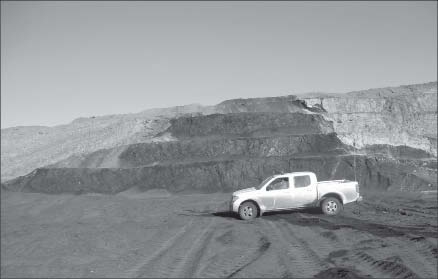Prophecy Coal (PCY-T) has outlined the feasibility of its plan to unlock value from its Chandgana coal deposit in northern Mongolia by building a 600-megawatt thermal power plant.
The company is considering the unusual route because the coal at Chandgana is of fairly low quality, coming in at 3,350 kilocalories per kilogram, making it less economical to transport by truck or rail.
But with Mongolia projected to have significant power deficiencies going forward, and the deposit situated only 120 km from the power grid and 350 km from China, there is potential for the company to boost the value of the project by generating its own power on site and selling it into the national grid.
The prefeasibility study just re leased outlines a post-tax US$364.7-million net present value and a 21.9% internal rate of return for the project, based on a 12% discount rate, a 10% debt interest rate, a 30-year life and an exchange rate of 1,250 Mongolian tugriks to the U.S. dollar.
The project would tap into the two deposits at Chandgana: the smaller, but already permitted, Chandgana Tal deposit has 141 million measured tonnes of coal and a 0.5-to-1 strip ratio, and would be directly beside the power plant; the larger, yet-to-be permitted Chandgana Khavtgai hosts 1.05 billion measured and indicated tonnes of coal, has a strip ratio of 2.2-to-1 and is located 9 km away.
Operating as a power plant rather than just a mine, the Chandgana project would be sensitive to electricity tariffs and coal prices. For the base-case study Prophecy assumes an electricity tariff of US6¢ per kilowatt hour, including coal, while a US0.5¢, or 8.3% increase, would bring the net present value to US$473.4 million and the internal rate of return to 24.8%. Mongolia imports some of its power from Russia at US8¢ per kilowatt hour.
Prophecy Coal expects capital costs for the power plant, transmission lines and administration to come in at US$744 million, not including mine costs. The company plans to raise 30% of the money from equity and the rest from debt with 10% interest and a 10-year payback. Capital costs translate to an estimated US2.23¢ per kilowatt hour.
The Mongolian government has already given Prophecy approval to build the project, so Prophecy’s next goals are to secure power purchase agreements and continue with engineering, procurement and financing, all of which should be completed later this year. The company plans to start construction in the second quarter of 2013 and finish two years later.
Looking further ahead, Prophecy envisions ramping up the power plant to 3,600 megawatts and exporting excess power to China.
As to Ulaan Ovoo, Prophecy’s other main asset, the company commissioned the mine in late 2010 but is not producing anywhere near the levels expected because of trouble securing acceptable offtake agreements. Sitting near the Russian border in Mongolia’s north, the 209 million measured and indicated tonnes at Ulaan Ovoo are of higher quality than Chandgana with a minimum of 5,000 kilocalories per kilogram, but problems securing rail and port allocation has set back the offtakes and mine ramp-up. The company reports it will continue to pursue the allocations later in 2012 but is concentrating on Chandgana for now.
In 2011 the company produced 200,000 tonnes of coal from the mine, but sells a good portion of that at or below cost to local power plants in Mongolia’s north. In 2012 Prophecy expects to produce 300,000 to 500,000 tonnes of coal at Ulaan Ovoo.
Prophecy Coal’s share price climbed 4¢, or 8.7%, to 46¢ on the Chandgana news with 3.2 million shares traded. The company has a 52-week share price range between 39¢ and $1.14. The company has 201 million shares out, or 237 million fully diluted.


Be the first to comment on "Prophecy Coal sets out financials for Mongolian power project"